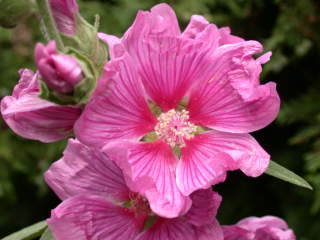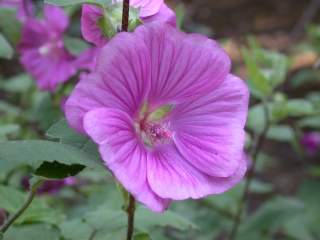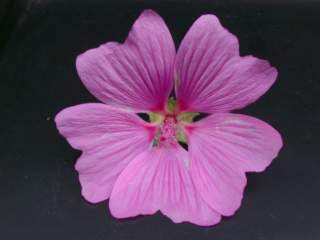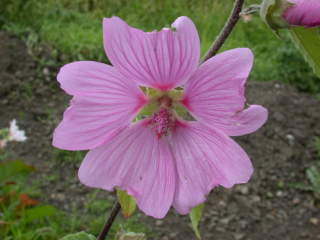










(partly
reverted)
Bride
Springs
Wine
Floss
Rose
back to Contents and Overview
Lavatera ×clementii Cheek
Lavatera ×clementii hybrids
The nothospecies (hybrid) Lavatera ×clementii Cheek contains all hybrids, including backcrosses, etc, between Lavatera olbia L. and Lavatera thuringiaca L. Several different cultivars belonging to this taxon are in cultivation. This page covers those cultivars for which I have seen an assignment to Lavatera ×clementii, or a documented parentage implying such an assignment, and also 'Barnsley Baby', on the assumption that it is a sport or seedling of 'Barnsley'. Other cultivars are described on the herbaceous and shrubby Lavateras pages.
Lavatera ×clementii is a variable taxon, generally intermediate between its parents.
It is largely sterile, most flowers abscissing just below the calyx without forming fruit, in constrast to its parent species. The nutlets, when developed, have one to few hairs on their dorsal faces, constrasting with the glabrous nutlets of Lavatera thuringiaca and the densely hispid nutlets of Lavatera olbia. Of the varieties that I grow, 'Candy Floss' and, especially, 'Bredon Springs' produce the most seed. The seed, when produced, can sometimes be germinated; I have raised seedlings of 'Barnsley', 'Bredon Springs', 'Candy Floss' and of a plant (Hinsley 13) of my own raising. Elsewhere there are records of seedlings being raised of 'Rosea'.
Low seed production is not confined to recognised cultivars of Lavatera ×clementii; at least two supposed cultivars of Lavatera olbia are largely sterile, and seed production from specimens of Lavatera thuringiaca can be sparse in some years.
Most cultivars are weak shrubs, similar to Lavatera olbia, but constrasting with the herbaceous habit of Lavatera thuringiaca. However in harsher climates the top growth may not survive the winter, and the plants are functionally herbaceous. 'Candy Floss' is functionally herbaceous with me, but might be shrubby in a warmer clime. Sub-sterile herbaceous cultivars of Lavatera do exist, but whether these belong to this hybrid or some other taxon is an open question.
 |
 |
 |
 |
 |
 |
 |
 |
 |
 |
 |
| Barnsley | Barnsley (partly reverted) |
Blushing Bride |
Bredon Springs |
Burgundy Wine |
Candy Floss |
Kew Rose |
Lisanne | Memories | Pavlova | Rosea |
Synonyms: Lavatera thuringiaca sensu Cheek and Lavatera olbia hort are synonyms of Lavatera ×clementii.
 ×clementii
Hinsley 13 [Arachne]: a seedling of my own raising, which is a cross between
Lavatera ×clementii 'Candy Floss' and Lavatera olbia
'Eyecatcher'. It favours the latter in appearance, differing from it in the
larger more open flowers and in details of the lobing of the leaves.
×clementii
Hinsley 13 [Arachne]: a seedling of my own raising, which is a cross between
Lavatera ×clementii 'Candy Floss' and Lavatera olbia
'Eyecatcher'. It favours the latter in appearance, differing from it in the
larger more open flowers and in details of the lobing of the leaves.
×clementii 'Barnsley': to 2m; flowers white with a pink eye, developing a pink tinge as they age. 'Barnsley' is a periclinal chimaera and can revert to 'Rosea'.
×clementii 'Barnsley Baby': presumably a dwarf sport or seedling of 'Barnsley'
×clementii 'Barnsley Perry's Dwarf': grown from a cutting (sport?) of 'Barnsley', this grows to 1.2m.
×clementii 'Blushing Bride': another cultivar derived from 'Barnsley'. The flowers are similar, but do not become pink with age. The stems are green, as opposed to the purplish colouration displayed by the stems of 'Barnsley' (and 'Rosea'). This cultivar is said not to revert, but the first flower to open on my specimen was a reversion to 'Rosea', and I have seen reverted and partially reverted flowers on several plants.
 ×clementii 'Bredon Springs':
this cultivar has deep rose (RHS 77B/88B) flowers, with broad, overlapping,
petals, lacking a constrasting central eye, but with prominent venation. The
flowers are rather densely borne on the stems.
×clementii 'Bredon Springs':
this cultivar has deep rose (RHS 77B/88B) flowers, with broad, overlapping,
petals, lacking a constrasting central eye, but with prominent venation. The
flowers are rather densely borne on the stems.
×clementii 'Bressingham Pink': flowers pale pink.
×clementii 'Burgundy Wine': a sprawling shrub to 1.2m, with flowers of a vivid light paeony purple. It is a seedling of 'Rosea'.
×clementii 'Candy Floss': flowers bright pink. This cultivar has a woody base, from which herbaceous top growth sprouts in autumn, and elongates in the flowering shoots the following spring. The previous summer's growth mostly dies back in autumn, and what remains is not frost hardy. I attempted to propagate this, unsuccessfully, in autumn, using soft cuttings. Either bottom heat is required, or cuttings should be taken in spring. It produces seed more readily than most forms of Lavatera ×clementii, and this seed will germinate, but does not come true from seed. Sometimes known as 'Cotton Candy' in the United States.
The Royal Horticultural Society list 'Candy Floss' as a cultivar of Lavatera ×clementii, which I assume is based on their RAPD assay of Lavatera species and cultivars. If not for this, I would have placed 'Candy Floss' in Lavatera thuringiaca.
×clementii CHAMALLOW® 'Inovera': a compact variety bred from 'Rosea' by INRA. From photographs the flowers appear to be a self-coloured pink.
×clementii 'Chedglow': a variegated ("cream and green variegation") sport of 'Barnsley'.
×clementii 'Chrisjen': a variegated ("patches and blotches of yellow and cream") sport of 'Barnsley'.
×clementii 'Cotton Candy': a name sometimes used for 'Candy Floss' in the USA.
×clementii 'Golden My Foot': pink flowered, yellow-green foliaged sport of 'Chedglow'.
 ×clementii 'Kew
Rose' is a seedling of × clementii 'Rosea' and is very similar to
the latter. It is a more robust plant, growing to 4m in height. I haven't
identified any single trait which can be used to distinguish it from 'Rosea',
the differences being mostly if not exclusively quantitative, and of traits
which are variable on both plants, depending on conditions of cultivation. The
flowers and leaves, and the hairs on the stem, of 'Kew Rose' are larger, and
the leaves more distinctly lobed and toothed
×clementii 'Kew
Rose' is a seedling of × clementii 'Rosea' and is very similar to
the latter. It is a more robust plant, growing to 4m in height. I haven't
identified any single trait which can be used to distinguish it from 'Rosea',
the differences being mostly if not exclusively quantitative, and of traits
which are variable on both plants, depending on conditions of cultivation. The
flowers and leaves, and the hairs on the stem, of 'Kew Rose' are larger, and
the leaves more distinctly lobed and toothed
×clementii 'Lara Rose': a form with irregular marginal yellow variegation.
×clementii 'Lavender Lady':
×clementii 'Lisanne': a cross between 'Barnsley' and 'Ice Cool', growing to 1m. The flowers are similar to 'Barnsley', but are a purer-white (the flowers of 'Barnsley' develop a distinct pinkish tinge).
×clementii 'Lutgarde': a pink-flowered sport of 'Barnsley'; 'Lutgarde' is a more robust plant than 'Rosea'.
×clementii 'Mary Hope'
×clementii MEMORIES 'Stelav': Flowers similar to those of 'Barnsley' and 'Lisanne', but with perhaps a less prominent eye. 'Memories' is the preferred selling name for 'Stelav' in the UK.
×clementii 'Paul Stevens' is a synonym for MEMORIES 'Stelav'.
×clementii 'Pavlova': pastel-pink flowers with white eyes, and non-overlapping petals. Plant growing to 1m.
×clementii 'Pink Barnsley': apparently an alternative name for 'Barnsley', referring to the pink colour acquired by the petals as they age.
×clementii 'Poynton Lady': a variegated sport of 'Rosea'.
×clementii 'Red Rum': a cultivar reaching 4-6 ft tall and 3-4 ft wide with felty, gray-green leaves and magenta-red flowers on burgundy stems.
 ×clementii 'Rosea': flowers
pinky-mauve.
×clementii 'Rosea': flowers
pinky-mauve.
×clementii 'Shorty': a semi-prostrate (to 1m) sport of 'Rosea'.
References
The thumbnail photographs of 'Barnsley', 'Burgundy Wine', 'Candy Floss', 'Kew Rose' and 'Rosea' are © Gerhard Sandtner, and are reproduced with permission. The remaining photographs are © Stewart Robert Hinsley
If you have found any errors on this page, or have any further information about the genus Lavatera then please contact me at botany@malvaceae.info.
back to Contents and Overview
© 1999-2005 Stewart Robert Hinsley